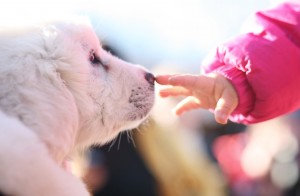 When you’re planning to introduce new pets into your home, there are certain protocols you can follow for best results.It’s never a simple task, but it doesn’t have to be a nightmare either.
When you’re planning to introduce new pets into your home, there are certain protocols you can follow for best results.It’s never a simple task, but it doesn’t have to be a nightmare either.
In fact, chances are things will go more smoothly than you expected – but that doesn’t mean a little prep won’t go a long way to make things easier on everybody.
If You Have Kids
If you’re bringing a new dog into a household with kids – especially very young ones – your first goal should be safety. Even the nicest, sweetest dog in the world can cause damage by knocking over a toddler accidentally. Plus, a lot of dogs find the sound of babies crying or loud noises unsettling, so they may need time to get used to that as well.
A good first step? Make sure the new pup is trained in basic commands, such as:
- Come
- Sit
- Stay
This will ensure you have complete control over your dog when introduction time comes around. Even better, make sure the introduction is done with the dog on a leash. Then allow the child and dog to meet without letting go. This does two things:
- it allows the dog to get to know the child’s scent, and
- it prevents unexpected accidents if the child suddenly screams or cries and startles the dog.
Over the next few days, monitor the interaction of children and dogs carefully. This will allow you to catch clues of behavior that needs to be modified, such as a dog stealing the baby’s toys or a toddler playing too roughly with the new pup. It’s also a great idea to make sure your kids understand how to properly pet and play with their new fur-sibling. Here are two wonderful resources geared towards younger children:
If You Have Another Pet
Chances are your current dog would need some time to adjust to the idea of having another pet around. The idea of sharing the territory (and you!) probably won’t be pleasant, so tons of attention and love towards the current home resident will go a long way.
If at all possible, make the first introduction in neutral territory, such as the local dog park or even just the sidewalk in front of your house. That way there’ll be less of a chance of fighting over territory or pressure to have them like each other right away. Better yet, ask a friend to hold the new dog firmly leashed while you bring your current dog out also on a leash. A little nose sniffing before leashes get loose, then a chance to spend some time romping around and getting to know each other before you head back home with both of them.
One word of caution: in the dog world, body language is everything. Tight, stiff body movements, hair raised on the back and neck, and growling are all signs that a fight might be about to break out. On the other hand, a relaxed open mouth (think “doggie smile”) and a wagging tail could be signs that a friendship is imminent and you can just let go.
Getting Your Home Ready
Puppies are very much like children when it comes to self-safety. If you’re bringing a little one into your home, you should make sure that there are no obvious dangers lurking around. Chemicals cleaners and other household products could be highly toxic, but puppies can also get into trouble by chewing on cords, swallowing small objects or even drinking toilet water if you add any special products to it.
A good way to make sure your home is safe is to lie down on the floor and look around. You’ll be at around the same height the dog will be and you should be able to catch potential threats you might not see otherwise.

